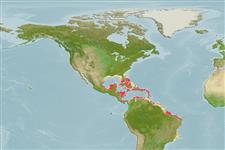>
Eupercaria/misc (Various families in series Eupercaria) >
Scaridae (Parrotfishes) > Scarinae
Etymology: Scarus: Greek, skaros = a fish described by anciente writers as a parrot fish; 1601 (Ref. 45335).
Environment: milieu / climate zone / depth range / distribution range
Ekologi
laut berasosiasi dengan karang; kisaran kedalaman 3 - 25 m (Ref. 9710). Tropical; 39°N - 24°S, 98°W - 31°W
Western Atlantic: Maryland in the USA, Bermuda and Bahamas to Rio de Janeiro, Brazil (Ref. 13628), including the West Indies (Ref. 3802); absent in the northern Gulf of Mexico.
Length at first maturity / Size / Weight / umur
Maturity: Lm ?, range 31 - ? cm
Max length : 120 cm TL jantan/; (Ref. 7251); common length : 35.0 cm TL jantan/; (Ref. 3802)
Duri punggung (Keseluruhan (total)) : 9; duri punggung lunak (Keseluruhan (total)) : 10; Duri dubur: 2; Sirip dubur lunak: 9. Adults uniformly blue, with yellow area on top of head that disappears in larger fish. Large fish develop prominent bulging snout and extended upper and lower caudal fin lobes. No other species has this uniform blue color in adults. (Ref. 26938).
Inhabits coral reefs. Juveniles found on Thalassia beds (Ref. 13628). Feeds on benthic plants and small organisms in the sand (Ref. 5521). Forms large spawning aggregations (Ref. 9710).
Life cycle and mating behavior
Kematangan | Reproduksi, perkembang biakan | Pemijahan | telur-telur | Fecundity | Larva
Oviparous, distinct pairing during breeding (Ref. 205).
Parenti, P. and J.E. Randall, 2000. An annotated checklist of the species of the labroid fish families Labridae and Scaridae. Ichthyol. Bull. J.L.B. Smith Inst. Ichthyol. (68):1-97. (Ref. 35918)
Status IUCN Red List (Ref. 130435: Version 2024-2)
ancaman kepada manusia
Reports of ciguatera poisoning (Ref. 4690)
penggunaan manusia
Perikanan: nilai komersial kecil; Ikan buruan: ya; Akuarium: Komersial
Alat, peralatan
laporan khas
muat turun XML
Sumber internet
Estimates based on models
Preferred temperature (Ref.
123201): 26.1 - 28.2, mean 27.4 °C (based on 685 cells).
Phylogenetic diversity index (Ref.
82804): PD
50 = 0.5000 [Uniqueness, from 0.5 = low to 2.0 = high].
Bayesian length-weight: a=0.01288 (0.00726 - 0.02285), b=3.04 (2.89 - 3.19), in cm total length, based on LWR estimates for this species & Genus-body shape (Ref.
93245).
Trophic level (Ref.
69278): 2.0 ±0.00 se; based on food items.
Generation time: 3.4 ( na - na) years. Estimated as median ln(3)/K based on 1
growth studies.
Daya lenting (Ref.
120179): sedang, Waktu penggandaan populasi minimum 1.4 - 4.4 tahun (Preliminary K or Fecundity.).
Fishing Vulnerability (Ref.
59153): Moderate vulnerability (42 of 100).
Nutrients (Ref.
124155): Calcium = 21.2 [13.4, 36.4] mg/100g; Iron = 0.618 [0.415, 0.940] mg/100g; Protein = 18.9 [16.7, 20.7] %; Omega3 = 0.0733 [, ] g/100g; Selenium = 24.4 [14.4, 40.4] μg/100g; VitaminA = 26.2 [7.6, 89.8] μg/100g; Zinc = 1.64 [1.22, 2.15] mg/100g (wet weight);
